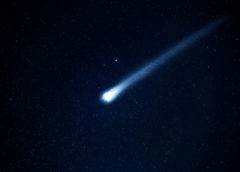A newly discovered comet has excited the astronomical community this week because it appears to have originated from outside the solar system.
The object is designated C/2019 Q4 (Borisov), and wasdiscovered on Aug. 30, 2019, by Gennady Borisov at the MARGO observatory in Nauchnij, Crimea.
The official confirmation that comet C/2019 Q4 is an interstellar comet has not yet been made, but if it is interstellar, it would be only the second such object detected.
The first object being ‘Oumuamua, which was observed and confirmed in October 2017.
C/2019 was flagged as possibly interstellar by the Scout System, which is located at NASA’s Jet Propulsion Laboratory, in Pasadena, California.
NASA’s Center for Near-Earth Object Studies at JPL worked with astronomers and the European Space Agency’s Near-Earth Object Coordination Center in Frascati, Italy, to obtain additional observations.
NASA-sponsored Minor Planet Center in Cambridge, Massachusetts, has worked to estimate the comet’s precise trajectory and determine whether it originated within our solar system or came from elsewhere in the galaxy.
The comet is currently 260 million miles from the Sun and will reach its closest point, or perihelion, on Dec. 8, 2019, at a distance of about 190 million miles. The comet also has a high velocity of about 93,000 mph, which is well above the typical velocities of objects orbiting the Sun at that distance.
Currently on an inbound trajectory, comet C/2019 Q4 is heading toward the inner solar system. On Oct. 26, it will pass through the ecliptic plane – the plane in which Earth and the other planets orbit the Sun – from above at roughly a 40-degree angle.
C/2019 Q4 can be seen with professional telescopes for months to come. “The object will peak in brightness in mid-December and continue to be observable with moderate-size telescopes until April 2020
After that, it will only be observable with larger professional telescopes through October 2020.
More information about asteroids and near-Earth objects can be found at:
https://www.jpl.nasa.gov/asteroidwatch
For more information about NASA’s Planetary Defense Coordination Office, visit:
https://www.nasa.gov/planetarydefense
For asteroid and comet news and updates, follow AsteroidWatch on Twitter:
Source: JPL

Rod is a blogger, writer, filmmaker, photographer, daydreamer who likes to cook. Rod produces and directs the web series, CUPIC: Diary of an Investigator. He is also the editor, producer and administrator of STM Daily News, a part of the TNC Network.


